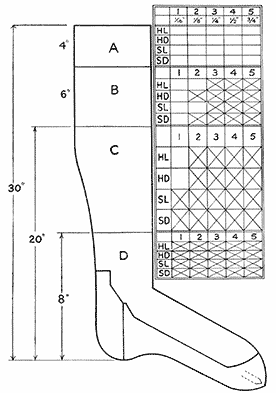


Certain silk fibre irregularities are not noticeable in a stocking of the colour “D” type; therefore, provision in grading is made accordingly. Also all imperfections up to a ¾" in length irregularity appearing in the welt of the stocking (area “A”) regardless of weight or colour, are passed by the examiner because this part of the stocking is normally covered during wear.
Area “B”. All imperfections up to 1⁄16" long in all weights and colours, also up to ¾" in light colours in both heavy and sheer stockings are ignored, the hose are considered firsts. All other irregularities should be noted and the hose reckoned as seconds.
Area “C”. All imperfections up to 1⁄16" long in heavy stockings—irrespective of colour—are ignored and the hose considered firsts. All other irregularities will be seconds.
Area “D”. All imperfections of whatever type will be considered irregulars.
On page 130, Fig. 62, a chart is given, showing according to position, whether a given type of silk fibre defect should be classified as a first or second.
Because rayon and nylon are man-made yarns of continuous filament, there is not the same risk of uneven yarn being knitted. This is in contrast to silk yarn, on which the irregularities due to the silkworm’s food have a distinct bearing. The silk substance is exuded from tiny holes in the body of the silkworm; this substance solidifies when coming into contact with the air and the silk filament sometimes varies—according to the rate of exudation by the silkworm—the variation being shown by a thickness occurring in the filament.
With rayon the spinning solution is fed to the spinning machines by being forced into the nozzle-head containing the spinneret and from the fine spinneret holes a flow of fine, separate filaments (to form a single thread) are drawn from each spinning unit. The thickness of the thread depends on the volume of spinning solution being supplied, and the number of filaments which are drawn from each nozzle. Therefore, it can be seen that a regular yarn (consisting of several filaments) can be obtained without the risk of irregularity, because of the correct pressure which is rigidly controlled to this end.